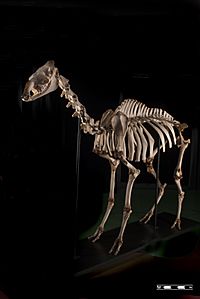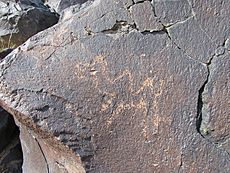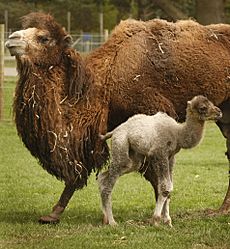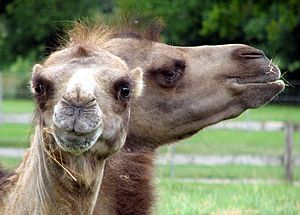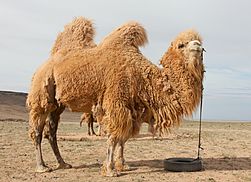Bactrian camel facts for kids
Quick facts for kids Bactrian camel |
|
|---|---|
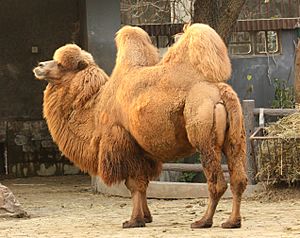 |
|
| A Bactrian camel in the Shanghai Zoo | |
| Conservation status | |
| Scientific classification | |
| Kingdom: | |
| Phylum: | |
| Class: | |
| Order: | |
| Family: | |
| Genus: | |
| Species: |
C. bactrianus
|
| Binomial name | |
| Camelus bactrianus Linnaeus, 1758
|
|
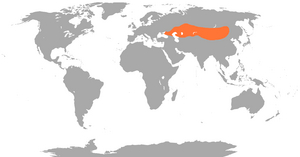 |
|
| Geographic range | |
The Bactrian camel (Camelus bactrianus), also known as the Mongolian camel, is a large even-toed ungulate native to the steppes of Central Asia.
It has two humps on its back, in contrast to the single-humped dromedary camel.
Its population of two million exists mainly in the domesticated form.
Their name comes from the ancient historical region of Bactria.
Domesticated Bactrian camels have served as pack animals in inner Asia since ancient times. With its tolerance for cold, drought, and high altitudes, it enabled the travel of caravans on the Silk Road.
Bactrian camels, whether domesticated or feral, are a separate species from the wild Bactrian camel, which is the only truly wild (as opposed to feral) species of camel in the world.
Contents
Taxonomy
|
||||||||||||||||||||||||||||||||||||||||||
| Phylogenetic relationships of the dromedary from combined analysis of all molecular data. |
The Bactrian camel shares the genus Camelus with the dromedary (C. dromedarius) and the wild Bactrian camel (C. ferus). The Bactrian camel belongs to the family Camelidae. The ancient Greek philosopher Aristotle was the first to describe the species of Camelus: in his 4th-century-BC History of Animals he identified the one-humped Arabian camel and the two-humped Bactrian camel. The Bactrian camel was given its current binomial name Camelus bactrianus by Swedish zoologist Carl Linnaeus in his 1758 publication Systema Naturae.
Description
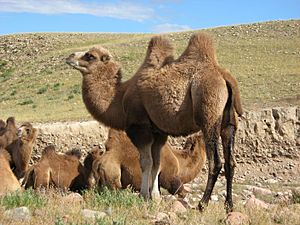
The Bactrian camel is the largest mammal in its native range and is the largest living camel.
Shoulder height is from 180 to 230 cm (5.9 to 7.5 ft), head-and-body length is 225–350 cm (7.38–11.48 ft), and the tail length is 35–55 cm (14–22 in).
Its long, wooly coat varies in colour from dark brown to sandy beige. A mane and beard of long hair occurs on the neck and throat, with hairs measuring up to 25 cm (9.8 in) long.
The shaggy winter coat is shed extremely rapidly, with huge sections peeling off at once, appearing as if sloppily shorn.
The two humps on the back are composed of fat (not water as is sometimes thought).
The face is typical of a camelid, being long and somewhat triangular, with a split upper lip. The long eyelashes, along with the sealable nostrils, help to keep out dust in the frequent sandstorms which occur in their natural range.
The two broad toes on each foot have undivided soles and are able to spread widely as an adaptation to walking on sand. The feet are very tough, as befits an animal of extreme environments.
Natural habitat
These camels are migratory, and their habitat ranges from rocky mountain massifs to flat arid desert, stony plains, and sand dunes.
Conditions are extremely harsh—vegetation is sparse, water sources are limited and temperatures are extreme, ranging from as low as −40 °C (−40 °F) in winter to 40 °C (104 °F) in summer.
The camels' distribution is linked to the availability of water, with large groups congregating near rivers after rain or at the foot of the mountains, where water can be obtained from springs in the summer months, and in the form of snow during the winter.
Life history
Bactrian camels are very good at coping with variations in temperature, ranging from freezing cold to blistering heat.
They have a remarkable ability to go without water for months at a time, but when water is available they may drink up to 57 liters at once.
When well fed, the humps are plump and erect, but as resources decline, the humps shrink and lean to the side.
When moving faster than a walking speed, they pace, by stepping forwards with both legs on the same side (as opposed to trotting, using alternate diagonals as done by most other quadrupeds). Speeds of up to 65 kilometres per hour (40 mph) have been recorded, but they rarely move this fast.
Bactrian camels are also said to be good swimmers.
The sense of sight is well developed and the sense of smell is extremely good.
The lifespan of Bactrian camels is estimated at up to 50 years, often 20 to 40 in captivity.
Diet
Bactrian camels are diurnal, sleeping in the open at night and foraging for food during the day.
They are primarily herbivorous. With tough mouths that can withstand sharp objects such as thorns, they are able to eat plants that are dry, prickly, salty or bitter, and can eat virtually any kind of vegetation. When other nutrient sources are not available, these camels may feed on carcasses, gnawing on bones, skin, or various different kinds of flesh.
In more extreme conditions, they may eat any material they find, which has included rope, sandals, and even tents. Their ability to feed on a wide range of foods allows them to live in areas with sparse vegetation.
The first time food is swallowed, it is not fully chewed. The partly masticated food (called cud) goes into the stomach and later is brought back up for further chewing.
Bactrian camels belong to a fairly small group of animals that regularly eat snow to provide their water needs.
Reproduction
Males during mating time are often quite violent and may bite, spit, or attempt to sit on other male camels.
Gestation lasts around 13 months. One or occasionally two calves are produced, and the female can give birth to a new calf every other year.
Young Bactrian camels are precocial, being able to stand and run shortly after birth, and are fairly large at an average birth weight of 36 kg (79 lb). They are nursed for about 1.5 years. The young calf stays with its mother for three to five years, and often serves to help raise subsequent generations for those years.
Wild camels sometimes breed with domesticated or feral camels.
Relationship to humans
The Bactrian camel is thought to have been domesticated (independent of the dromedary) sometime before 2500 BC in Northeast Afghanistan or southwestern Turkestan. The dromedary camel is believed to have been domesticated between 4000 BC and 2000 BC in Arabia.
As pack animals, these ungulates are virtually unsurpassed, able to carry 170–250 kg (370–550 lb) at a rate of 47 km (30 miles) per day, or 4 km/h (2 mph) over a period of four days. Furthermore, Bactrian camels are frequently ridden, especially in desertified areas. In ancient Sindh, for example, Bactrian camels of two humps were initially used by the rich for riding. The camel was later brought to other areas such as Balochistan and Iran for the same purpose.
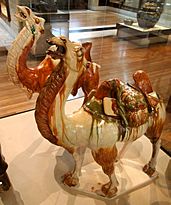
Bactrian camels have been the focus of artwork throughout history. For example, western foreigners from the Tarim Basin and elsewhere were depicted in numerous ceramic figurines of the Chinese Tang dynasty (618–907).
United States imports
Bactrian camels were imported to the US several times in the mid- to late 1800s, both by the US military and by merchants and miners, looking for pack animals sturdier and hardier than horses and mules. Most of these camels were eventually turned loose to survive in the wild. As a result, small feral herds of Bactrian camels existed during the late 19th century in the southwest deserts of the United States.
Military use
The Indian Army uses these camels to patrol in Ladakh. They decided that double-humped camels are better suited for the task at hand and the conditions. They can carry loads of 170 kilograms (370 lb) at more than 17,000 feet (5,200 m) which is much more than the ponies that are being used as of now. They can survive without water for at least 72 hours.
Population
| Country | Population |
|---|---|
| Mongolia | 430,000 |
| China | 270,000 |
| Kazakhstan | 200,000 |
| Kyrgyzstan | 50 |
| Uzbekistan | 10,000 |
| Iran | >100 |
| Afghanistan | Unknown |
| Pakistan | 200 |
| Turkmenistan | 2,500 |
| India | 150 |
| Azerbaijan | Unknown |
| Russia | 100,000 |
| Total | >1,000,000 |
Images for kids
-
Riding a Bactrian camel in Nubra Valley, India
-
Bactrian camels in the Chuya Steppe, Altai Mountains, Russia
-
Bactrian Camel on a farm in Vermont, US
See also
 In Spanish: Camello bactriano para niños
In Spanish: Camello bactriano para niños


